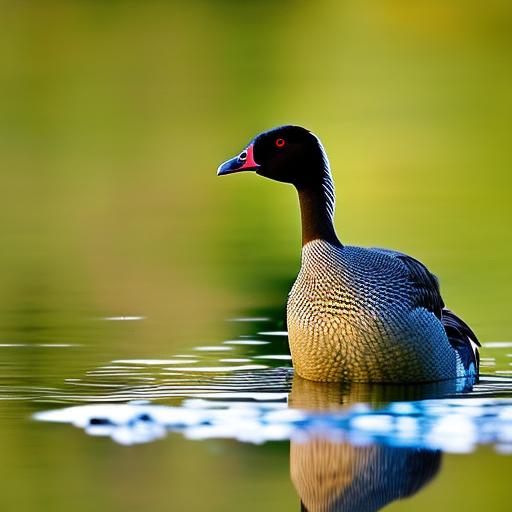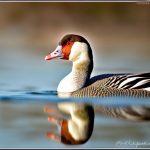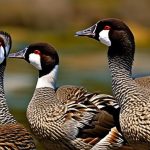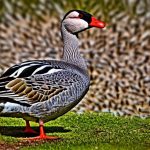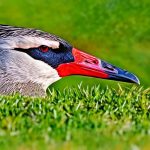Geese infestations around ponds and lakes can be a major problem for property owners. These birds are attracted to these areas because they provide a suitable habitat for nesting and feeding. However, their presence can lead to a number of issues, including damage to property, water pollution, and aggressive behavior towards humans and other animals. Fortunately, there are several methods that can be used to manage geese populations and mitigate these problems.
One of the most effective ways to manage geese populations is by understanding their behavior and implementing strategies that discourage them from nesting and feeding in the area. This can include installing physical barriers, using scare tactics, creating natural barriers with plants and landscaping, implementing sound deterrents, removing food sources, keeping the area clean and tidy, using visual deterrents, installing motion-activated sprinklers, and seeking professional help.
Key Takeaways
- Geese are attracted to open water and grassy areas, making ponds a prime location for them.
- Physical barriers such as fences or netting can prevent geese from accessing your pond.
- Scare tactics such as decoys or loud noises can deter geese from visiting your pond.
- Planting tall grasses or shrubs around your pond can create a natural barrier that geese will avoid.
- Sound deterrents such as ultrasonic devices or predator calls can be effective in repelling geese.
Understanding the Behavior of Geese
To effectively manage geese populations, it is important to understand why they are attracted to ponds and lakes in the first place. Geese are attracted to these areas because they provide a suitable habitat for nesting and feeding. Ponds and lakes offer a source of water for drinking and bathing, as well as a variety of aquatic plants and insects that geese feed on.
Geese are social animals that live in flocks. They are highly adaptable and can quickly become accustomed to human presence. Geese are also territorial and will aggressively defend their nesting sites. This can lead to conflicts with humans and other animals.
To manage geese populations, it is important to implement strategies that discourage them from nesting and feeding in the area. This can include installing physical barriers, using scare tactics, creating natural barriers with plants and landscaping, implementing sound deterrents, removing food sources, keeping the area clean and tidy, using visual deterrents, installing motion-activated sprinklers, and seeking professional help.
Installing a Physical Barrier around Your Pond
Installing a physical barrier around your pond can be an effective way to manage geese populations. A physical barrier can prevent geese from accessing the water and nesting in the area. There are several benefits to installing a physical barrier.
First, a physical barrier can create a clear boundary between the pond and the surrounding area. This can help deter geese from approaching the water and nesting in the area. Second, a physical barrier can provide protection for other wildlife that may be negatively impacted by geese infestations. Finally, a physical barrier can help maintain the aesthetic value of the pond and surrounding area.
There are several types of physical barriers that can be used to manage geese populations. One option is to install a fence around the perimeter of the pond. This can be an effective way to keep geese out of the area. Another option is to install netting over the water surface. This can prevent geese from landing on the water and accessing the area.
Using Scare Tactics to Keep Geese Away
Scare tactics can be an effective way to keep geese away from ponds and lakes. Scare tactics work by creating an environment that is uncomfortable or frightening for geese, causing them to avoid the area. There are several scare tactics that can be used to manage geese populations.
One common scare tactic is the use of noise makers, such as air horns or whistles. These devices emit loud noises that startle geese and encourage them to leave the area. Another scare tactic is the use of visual deterrents, such as scarecrows or reflective tape. These visual deterrents create a sense of danger for geese and discourage them from approaching.
While scare tactics can be effective in managing geese populations, there are some drawbacks to consider. Scare tactics may only provide temporary relief, as geese can quickly become accustomed to them. Additionally, scare tactics may not be suitable for all environments, as they can be disruptive to humans and other wildlife.
Creating a Natural Barrier with Plants and Landscaping
Creating a natural barrier with plants and landscaping can be an effective way to manage geese populations. This method works by creating an environment that is less attractive to geese, discouraging them from nesting and feeding in the area. There are several benefits to using plants and landscaping as a natural barrier.
First, plants and landscaping can provide visual barriers that make it difficult for geese to access the water. This can discourage them from approaching the area and nesting in the vicinity. Second, plants and landscaping can provide alternative food sources for geese, reducing their reliance on the pond or lake. Finally, plants and landscaping can enhance the aesthetic value of the area, making it more enjoyable for humans and other wildlife.
There are several types of plants that can be used to create a natural barrier. Tall grasses and shrubs can provide visual barriers that make it difficult for geese to access the water. Native plants that are not attractive to geese can also be used to discourage them from nesting and feeding in the area.
Implementing Sound Deterrents to Repel Geese
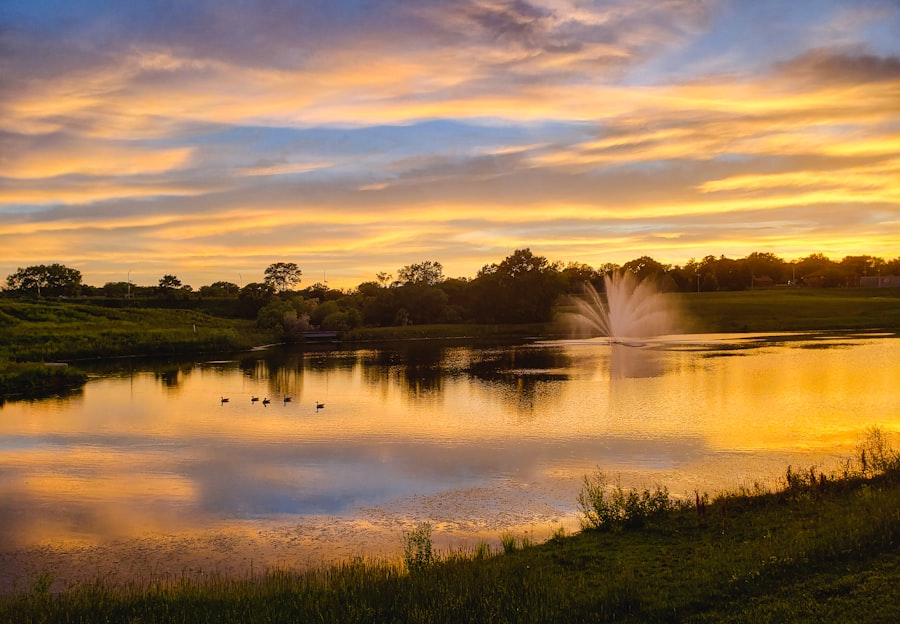
Implementing sound deterrents can be an effective way to repel geese from ponds and lakes. Sound deterrents work by emitting loud noises or predator calls that scare geese away. There are several benefits to using sound deterrents.
First, sound deterrents can be highly effective in repelling geese from an area. The loud noises or predator calls create a sense of danger for geese, causing them to avoid the area. Second, sound deterrents are non-lethal and do not harm geese or other wildlife. Finally, sound deterrents are relatively easy to install and maintain.
There are several types of sound deterrents that can be used to repel geese. One option is to use a sonic device that emits loud noises or predator calls. These devices can be programmed to emit sounds at regular intervals, creating a sense of danger for geese. Another option is to use a motion-activated sound deterrent that emits loud noises or predator calls when geese approach the area.
Removing Food Sources to Discourage Geese from Visiting
Removing food sources can be an effective way to discourage geese from visiting ponds and lakes. Geese are attracted to these areas because they provide a source of food, such as aquatic plants and insects. By removing these food sources, geese are less likely to visit the area.
There are several types of food sources that can attract geese. Aquatic plants, such as algae and duckweed, can provide a source of food for geese. Insects that live in or around the water can also attract geese. By removing these food sources, geese are less likely to visit the area.
To remove food sources, it is important to regularly maintain the pond or lake. This can include removing excess vegetation, such as algae or duckweed, and controlling insect populations. It is also important to properly dispose of any food waste or scraps that may attract geese.
Keeping the Area Around Your Pond Clean and Tidy
Keeping the area around your pond clean and tidy can be an effective way to manage geese populations. Geese are attracted to areas that provide suitable nesting and feeding sites. By keeping the area clean and tidy, you can discourage geese from nesting and feeding in the vicinity.
There are several ways to keep the area around your pond clean and tidy. Regularly removing debris, such as fallen leaves or branches, can help maintain a clean environment. It is also important to properly dispose of any trash or litter that may accumulate in the area.
In addition to keeping the area clean and tidy, it is also important to regularly maintain the vegetation around the pond. This can include trimming overgrown plants or trees that may provide nesting sites for geese. By keeping the area well-maintained, you can discourage geese from nesting and feeding in the vicinity.
Using Visual Deterrents to Scare Geese Away
Using visual deterrents can be an effective way to scare geese away from ponds and lakes. Visual deterrents work by creating a sense of danger or discomfort for geese, causing them to avoid the area. There are several benefits to using visual deterrents.
First, visual deterrents can be highly effective in scaring geese away from an area. The presence of visual deterrents, such as decoy predators or reflective tape, creates a sense of danger for geese, causing them to avoid the area. Second, visual deterrents are non-lethal and do not harm geese or other wildlife. Finally, visual deterrents are relatively easy to install and maintain.
There are several types of visual deterrents that can be used to scare geese away. One option is to use decoy predators, such as plastic owls or coyotes. These decoys create a sense of danger for geese, causing them to avoid the area. Another option is to use reflective tape or flags that move in the wind. The movement and reflection of these visual deterrents create a sense of danger or discomfort for geese.
Installing Motion-Activated Sprinklers to Keep Geese at Bay
Installing motion-activated sprinklers can be an effective way to keep geese at bay. Motion-activated sprinklers work by detecting the movement of geese and spraying water in their direction. This startles geese and encourages them to leave the area.
There are several benefits to using motion-activated sprinklers. First, motion-activated sprinklers provide a non-lethal and humane way to deter geese from ponds and lakes. The sudden spray of water startles geese and encourages them to avoid the area. Second, motion-activated sprinklers are relatively easy to install and maintain. They can be set up to detect the movement of geese and activate only when necessary.
There are several types of motion-activated sprinklers that can be used to keep geese at bay. One option is to use a sprinkler that is specifically designed to deter geese. These sprinklers are equipped with motion sensors that detect the movement of geese and activate the sprinkler. Another option is to use a regular motion-activated sprinkler that is commonly used for watering gardens or lawns.
Seeking Professional Help to Manage Geese Infestations
In some cases, it may be necessary to seek professional help to manage geese infestations. Professional help can provide expertise and resources that may not be available to property owners. There are several types of professionals that can be hired to manage geese infestations.
One option is to hire a wildlife control professional. These professionals specialize in managing wildlife populations and can provide effective strategies for managing geese infestations. Another option is to hire a landscaping professional. These professionals can provide expertise in creating natural barriers with plants and landscaping.
It is important to choose a professional who has experience in managing geese populations and understands the specific needs of your property. They can assess the situation, develop a management plan, and implement strategies that are tailored to your needs.
Geese infestations around ponds and lakes can be a major problem for property owners. However, there are several methods that can be used to manage geese populations and mitigate these problems. By understanding the behavior of geese and implementing strategies that discourage them from nesting and feeding in the area, property owners can effectively manage geese infestations.
These methods include installing physical barriers, using scare tactics, creating natural barriers with plants and landscaping, implementing sound deterrents, removing food sources, keeping the area clean and tidy, using visual deterrents, installing motion-activated sprinklers, and seeking professional help. By taking action to manage geese infestations, property owners can maintain the aesthetic value of their ponds and lakes and reduce the negative impacts of geese on their property.
If you’re looking for ways to keep geese out of your pond, you might also be interested in learning how to create a safe and comfortable environment for your chickens. Poultry Wizard offers a helpful article on “Chicken Coop Nest Box” that provides valuable insights on designing and maintaining a functional nesting area for your feathered friends. By implementing effective strategies to protect your chickens, you can also apply some of these techniques to deter geese from invading your pond. Check out the article here for more information.
FAQs
What are some common problems caused by geese in ponds?
Geese can cause a number of problems in ponds, including excessive algae growth, water pollution, damage to pond banks and vegetation, and the spread of disease.
What are some effective ways to keep geese out of my pond?
Some effective ways to keep geese out of your pond include installing fencing or netting around the pond, using decoys or scare devices, planting vegetation that geese dislike, and using sound or light deterrents.
What are some natural ways to deter geese from my pond?
Some natural ways to deter geese from your pond include planting vegetation that geese dislike, using natural predators like dogs or hawks, and using reflective surfaces like mirrors or shiny objects to scare geese away.
What should I do if geese have already taken up residence in my pond?
If geese have already taken up residence in your pond, it is important to discourage them from staying by removing any food sources, using scare devices, and making the area around the pond less attractive to geese. It may also be necessary to seek professional help to safely remove the geese from your property.
Are there any legal restrictions on how I can keep geese out of my pond?
There may be legal restrictions on how you can keep geese out of your pond, depending on where you live and the species of geese in question. It is important to check with your local wildlife agency or conservation department to ensure that you are following all applicable laws and regulations.
Meet Walter, the feathered-friend fanatic of Florida! Nestled in the sunshine state, Walter struts through life with his feathered companions, clucking his way to happiness. With a coop that’s fancier than a five-star hotel, he’s the Don Juan of the chicken world. When he’s not teaching his hens to do the cha-cha, you’ll find him in a heated debate with his prized rooster, Sir Clucks-a-Lot. Walter’s poultry passion is no yolk; he’s the sunny-side-up guy you never knew you needed in your flock of friends!

